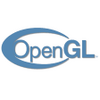An open source, application-programming interface that's great at scaling vector 2D and 3D graphics
An open source, application-programming interface that's great at scaling vector 2D and 3D graphics
Vote: (1,311 votes)
Program license: Free
Developer: Open GL
Version: 4.6
Works under: Windows
Vote:
Program license
(1,311 votes)
Free
Developer
Version
Open GL
4.6
Works under:
Windows
Pros
- All vectors and applications made with OpenGL are universal and work with other devices and systems
- Graphics and applications have great scalability and can work with weak or strong computers
- There are constant updates to ensure the program gets better
Cons
- Some extensions won't work based on your computer
OpenGL is a vector graphics program that creates images in 2D and 3D. This is a surprisingly versatile program that allows users to make graphics with a variety of programming languages. As an open-source program it's easy to find third-party additions that add even more functionality to the program.
Resource Identification
Most people won't be used OpenGL as an endpoint for their graphics creation. This is a good place to start, but the majority of graphics made with this program will be imported into another program for further use. Because of this, OpenGL is very explicit with information about how much power is needed for each graphic. It explicitly states this information so that designers can figure out the best way to configure all the graphics they need for their final project.
Quick Development
OpenGL has been around since 1992 and has vastly improved its developed cycle. Many of the graphics and interactive applications made here can be developed quickly by those who are fluent with programming languages. Programs and graphics made with OpenGL are commonly used with medical imagery, entertainment, broadcasting, virtual reality and much more.
Many of the newest features and updates are aimed at making the program respond faster to developers. There are numerous tools for texture mapping, visualization and rapid deployment of the created application. Not only that, but this program focuses on universality and ensures that the graphics work with all computers and operating systems.
Various Languages and Additions
OpenGL is known for supporting a large number of programming languages. This ensures that you can work in whichever language is best for the project or whichever one you know the best. Some of the languages include Java, C, C++, Ada and Fortran. You'll have no problem adding your specific programming and they will quickly bind to the graphics and document. Another thing to note is that these programming languages are known to work well on all systems and computers. This furthers OpenGL's principle of being a universal program that works for everyone.
As an open-source program you'll find that OpenGL supports a large number of third-party additions and extensions. This program has been around for decades and many developers have made tools to help themselves and the community. Unlike some programs that are completely overhauled, OpenGL has kept the same major framework for many years. This ensures that even older extensions should have no problem integrating with the program.
The only limitation is your own hardware. While OpenGL is made to be universal, the extensions might have limitations based on operating system and processing power. For example, you might have a hard time running a new extension on an older computer if your CPU is weak. Aside from this you should have no problem installing extensions into this program.
Extensions can do many things. They might add entirely new tools and functions. Some will combine routine functions into a single button press so that your developing time reduced. Most users have at least a few extensions on their OpenGL installation.
Scalability
Scalability is a concern for every developer. You usually can't make a program too big or it may not run on some computers. OpenGL has very few problems with scalability and any programs or graphics made with this program should be able to run on any compatible system. From mobile devices to the largest and strongest supercomputers, OpenGL is capable of working with everything.
Another thing to note is that OpenGL programs often require significantly less coding than other applications. This is because OpenGL is meant to work the same for all systems. Developers know that a large amount of their coding is dedicated to making features work with certain systems. For example, you might have to code a certain feature multiple times just to ensure it works with various computers. Not only is this tedious, but it makes the program significantly larger. OpenGL avoids this. You only have to program the feature once and that's it.
Regular Updates
One of the best things about OpenGL is that it's still being updated. This program has been around for decades and is constantly getting updates that improve functionality or make the interface even easier. Sweeping changes are uncommon. The updates are more about fixing what works and making it better. You'll find that OpenGL literally gets better with age.
Many times you'll also find that popular extensions become regular features. For example, if the OpenGL team notices that many users are installing a certain extension because it adds a specific tool, then they will add this tool to the default version of OpenGL. The developers listen to the community and try to add what they want and make changes that people ask for.
Vector Graphics
One of the most important aspects of OpenGL is its use of vector graphics. This program makes it simple to create vectors to use with other programs or in your applications. For those who don't know, vectors are images that can infinite scale up and down. You can make them tiny or huge. They will maintain the same quality and this ensures that the graphic will look good on any screen.
Making detailed vectors can be difficult without the right program. OpenGL ensures that all 2D and 3D graphics are made in this format.
Pros
- All vectors and applications made with OpenGL are universal and work with other devices and systems
- Graphics and applications have great scalability and can work with weak or strong computers
- There are constant updates to ensure the program gets better
Cons
- Some extensions won't work based on your computer
Pros
- Wide Support
- Extremely Quick
- Relatively Simple
Cons
- Basic Limitations
OpenGL is a piece of software that is entirely free and open-source, and it provides users with an application programming interface, or API, for graphical content. The software is surprisingly common even if it's not explicitly obvious every time you use it or something created with it.
One of the most powerful features of OpenGL is that the software isn't limited to software rendering. It gains access to your system's graphics card in order to provide hardware rendering, which is generally of a higher quality and doesn't rely on the power of the CPU. Perhaps the most common utility of this software is to scale 2D and 3D vector graphics. This version of the software is designed for the Windows operating system, but there are versions of the tool for each of the popular operating systems on the market.
While OpenGL is focused on graphic quality, it isn't sufficient for top-tier games that require excessive polygons. That's not to say that the software is never used for games, because that certainly wouldn't be true. In fact, it's often used for simpler games that don't have a lot of intense graphics. It's also commonly used for standard non-game apps that use a lot of graphics.
If OpenGL is used to run emulation software or games that don't require high numbers of polygons, it has exceptionally high speed and excellent stability. The system is easy to learn since it's so common and there's so much documentation for it online, and most apps that use OpenGL can be tweaked to work on other operating systems. The flexibility of OpenGL is unmatched in its category.
There's a good chance you've encountered the OpenGL software at some point in the past without realizing what you experienced. In fact, the software is so common that you've probably been in contact with one form of it or another many, many times over the course of your life. The software was initially released nearly 25 years ago, and it is still going strong thanks to frequent updates and the original quality of the system.
You can rest assured that you'll be successful if you want to take advantage of an OpenGL module to make one of your apps fully functional. This API is a great starting point if you are trying to learn 3D graphic programming. Even if you have no idea what you're doing or where to get started, the software will provide everything you need to get off the ground. You'll be able to use the software many, many times after it has been downloaded and installed, and it provides an excellent jumping-off point for graphic programmers who are new to the field. It lacks some of the most advanced functions and abilities of other benchmark graphic systems like DirectX, but that helps the software maintain an accessible level of utility.
Pros
- Wide Support
- Extremely Quick
- Relatively Simple
Cons
- Basic Limitations




